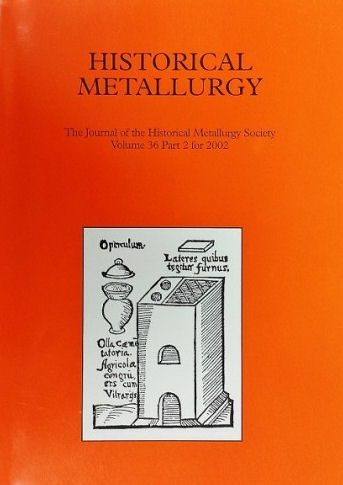Tin smelting slags from Crift Farm, Cornwall, and the effect of changing technology on slag composition
Abstract
Tin-smelting slag from an early medieval site at Crift Farm in Cornwall was analysed using SEM/EDS. A comparison was made between the chemical composition of this slag, which was produced by a simple hand-blowing technology, and slag from seven tin-working sites of later date which employed a more sophisticated water-powered blowing-house technology. The chemical compositions of areas within single pieces of slag were found to be highly variable. This is suggestive of a highly viscous material, with little mixing during smelting. The Crift Farm slag was found to have a chemical composition sufficiently similar to the later ‘blowing house’ slags that it could not be distinguished from them by this method of analysis.
##plugins.themes.bootstrap3.article.details##
Keywords
References
Adriaens A 1996, ‘Elemental Composition and Microstructure of Early Bronze Age and Medieval Tin Slags’, Mikrochimica Acta 124, 89–98.
Aylett J 1996, Medieval Tin Smelting and the Characterisation of Tin Slag from Crift Farm, Cornwall, unpublished BSc dissertation: University of Bradford.
Buckley A and Earl B 1990, ‘Preliminary Report on the Tin and Iron Working Site at Crift Farm’, Journal of the Trevithick Society 17, 66–77.
Dines H G 1969, The Metalliferous Mining Region of South West England (London).
Earl B 1985, ‘Melting Tin in the West of England: A Study of an Old Art’, Historical Metallurgy 19/2, 153–161.
Earl B 1991, ‘Tin Preparation and Smelting’, in Day J and Tylecote R F (eds) The Industrial Revolution in Metals, Institute of Metals, 37–83.
Gerrard G A M 1986, The Early Cornish Tin Industry, unpublished PhD thesis: University of Wales, Lampeter.
Greeves T 1981, ‘The Archaeological Potential of the Devon Tin Industry’ in Crossley D W (ed), Mediaeval Industry, CBA Research Report 40 (London).
Hatcher J 1970, Rural Economy and Society in the Duchy of Cornwall 1300 –1500 (Cambridge).
Malham A 1996, The Composition and Interpretation of Tin Smelting Slags from Crift Farm, Cornwall, unpublished MPhil thesis: University of Bradford.
McDonnell J G 1993, The Crift Farm Project Interim Report December 1993, Department of Archaeological Sciences, University of Bradford (unpublished).
McDonnell J G 1994, The Crift Farm Project Interim Report 1994, Department of Archaeological Sciences, University of Bradford (unpublished).
Palmer D and Easterbrook G 1999, Earth Materials (The Open University).
Salter C J 1997, ‘A Note on the Tin Slags from Caerloggas Down, Cornwall and the Upper Merrivale Blowing House, Devon’, in Budd P and Gale D (eds), Prehistoric Extractive Metallurgy in Cornwall, 45–49.
Sanderson D C W and Hunter J R 1981, ‘Composition Variability in Vegetable Ash’ Science and Archaeology 23, 27–30.
Thomas G 2000, A Chemical and Minerological Investigation of Bloomery Ironmaking in the Bristol Channel Orefield, UK, unpublished PhD thesis: University of Wales.
Tylecote R F, Photos E and Earl B 1989, ‘The Composition of Tin Slags from the South west of England’, World Archaeology 20, 432–445.
Aylett J 1996, Medieval Tin Smelting and the Characterisation of Tin Slag from Crift Farm, Cornwall, unpublished BSc dissertation: University of Bradford.
Buckley A and Earl B 1990, ‘Preliminary Report on the Tin and Iron Working Site at Crift Farm’, Journal of the Trevithick Society 17, 66–77.
Dines H G 1969, The Metalliferous Mining Region of South West England (London).
Earl B 1985, ‘Melting Tin in the West of England: A Study of an Old Art’, Historical Metallurgy 19/2, 153–161.
Earl B 1991, ‘Tin Preparation and Smelting’, in Day J and Tylecote R F (eds) The Industrial Revolution in Metals, Institute of Metals, 37–83.
Gerrard G A M 1986, The Early Cornish Tin Industry, unpublished PhD thesis: University of Wales, Lampeter.
Greeves T 1981, ‘The Archaeological Potential of the Devon Tin Industry’ in Crossley D W (ed), Mediaeval Industry, CBA Research Report 40 (London).
Hatcher J 1970, Rural Economy and Society in the Duchy of Cornwall 1300 –1500 (Cambridge).
Malham A 1996, The Composition and Interpretation of Tin Smelting Slags from Crift Farm, Cornwall, unpublished MPhil thesis: University of Bradford.
McDonnell J G 1993, The Crift Farm Project Interim Report December 1993, Department of Archaeological Sciences, University of Bradford (unpublished).
McDonnell J G 1994, The Crift Farm Project Interim Report 1994, Department of Archaeological Sciences, University of Bradford (unpublished).
Palmer D and Easterbrook G 1999, Earth Materials (The Open University).
Salter C J 1997, ‘A Note on the Tin Slags from Caerloggas Down, Cornwall and the Upper Merrivale Blowing House, Devon’, in Budd P and Gale D (eds), Prehistoric Extractive Metallurgy in Cornwall, 45–49.
Sanderson D C W and Hunter J R 1981, ‘Composition Variability in Vegetable Ash’ Science and Archaeology 23, 27–30.
Thomas G 2000, A Chemical and Minerological Investigation of Bloomery Ironmaking in the Bristol Channel Orefield, UK, unpublished PhD thesis: University of Wales.
Tylecote R F, Photos E and Earl B 1989, ‘The Composition of Tin Slags from the South west of England’, World Archaeology 20, 432–445.
How to Cite
Malham, A., Aylett, J., Higgs, E., & McDonnell, G. (2022). Tin smelting slags from Crift Farm, Cornwall, and the effect of changing technology on slag composition. Historical Metallurgy, 36(2), 84-94. https://hmsjournal.org/index.php/home/article/view/265
Issue
Section
Articles
How to Cite
Malham, A., Aylett, J., Higgs, E., & McDonnell, G. (2022). Tin smelting slags from Crift Farm, Cornwall, and the effect of changing technology on slag composition. Historical Metallurgy, 36(2), 84-94. https://hmsjournal.org/index.php/home/article/view/265


